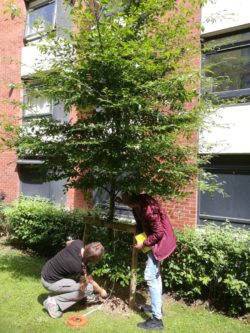Plants and the Atmosphere

Trees take in carbon dioxide (CO2), and give out oxygen – but they also emit other, highly reactive, gases such as isoprene and monoterpenes into the air. These gases, known as biogenic volatile organic compounds (BVOCs), are important because they are emitted in large quantities and react with oxidising molecules, such as ozone (O3) and the hydroxyl radical (OH) to form secondary organic aerosols. This reactivity means that BVOCs make an important contribution to the composition of the atmosphere wherever they are emitted. The level of OH and O3 present in the atmosphere, or its “oxidising capacity”, is important as this controls the lifetime of other gases, such as methane (CH4).
After reacting with oxidant compounds, BVOCs form larger compounds that can stick onto particles in the atmosphere, and potentially form new ones. The emission of BVOCs therefore influences the size and number of particles in the atmosphere, which in turn determines the number of cloud droplets forming in clouds. The number of cloud droplets controls the brightness of the clouds, and how much incoming solar radiation they reflect back to space. Researchers from the Institute for Climate and Atmospheric Science quantified this effect using detailed global model simulations and found that the emission of BVOCs by vegetation is having a cooling effect on the climate.

Research has also found that particles formed in the atmosphere with BVOCs increase the amount of light reaching trees, by diffusing sunlight, enhancing the trees’ primary productivity. This was estimated to increase the amount of carbon absorbed by the world’s forests by approximately 1 GtC each year. It was also estimated that the energy trees expend when releasing these BVOCs is less than half of that which they gain through increased photosynthesis.
Researchers in the LEAF network are also investigating the feedback between natural aerosol production and the climate. It is expected that climate change and increased concentrations of CO2 in the atmosphere will lead to changes in the extent and types of vegetation present in the biosphere, which will determine the release of BVOCs and emissions of aerosols from vegetation fires. On the other hand, human activities such as land-use change and management alter the release of BVOCs and fire emissions which influences the climate effects. Read more about the complex interactions here.

The removal of CO2 from the atmosphere by vegetation can help us to mitigate climate change. This is one of the many reasons tree planting has received so much attention in recent years. Researchers working in collaboration with UBoC are investigating the climate and air quality benefits of trees by measuring the sequestration and storage of CO2, and pollution removal of different trees in Leeds. The group is working in collaboration with the White Rose Forest to develop tree planting strategies, such as that for Leeds.
The removal of pollutants from the atmosphere by vegetation brings benefits for human health, but burning vegetation degrades air quality by increasing the concentration of particulate matter in the atmosphere. Many researchers in the LEAF network are exploring the impact of forest fires on atmospheric composition, and the impacts for human health. Check out our forest fires page here.
There are lots of researchers in the LEAF network studying the interesting interactions between plants and the atmosphere. Colleagues in the School of Geography such as Dr Roel Brienen, Dr David Galbraith and Professor Simon Lewis, amongst many others, are contributing to a wide body of research looking at the impact of atmospheric gases on tree health and their thermal sensitivity. To learn more about BVOCs, key researchers include Dr Cat Scott and Dr Alex Rap.
Check out the LEAF news page for blogs about recent research from the network.
